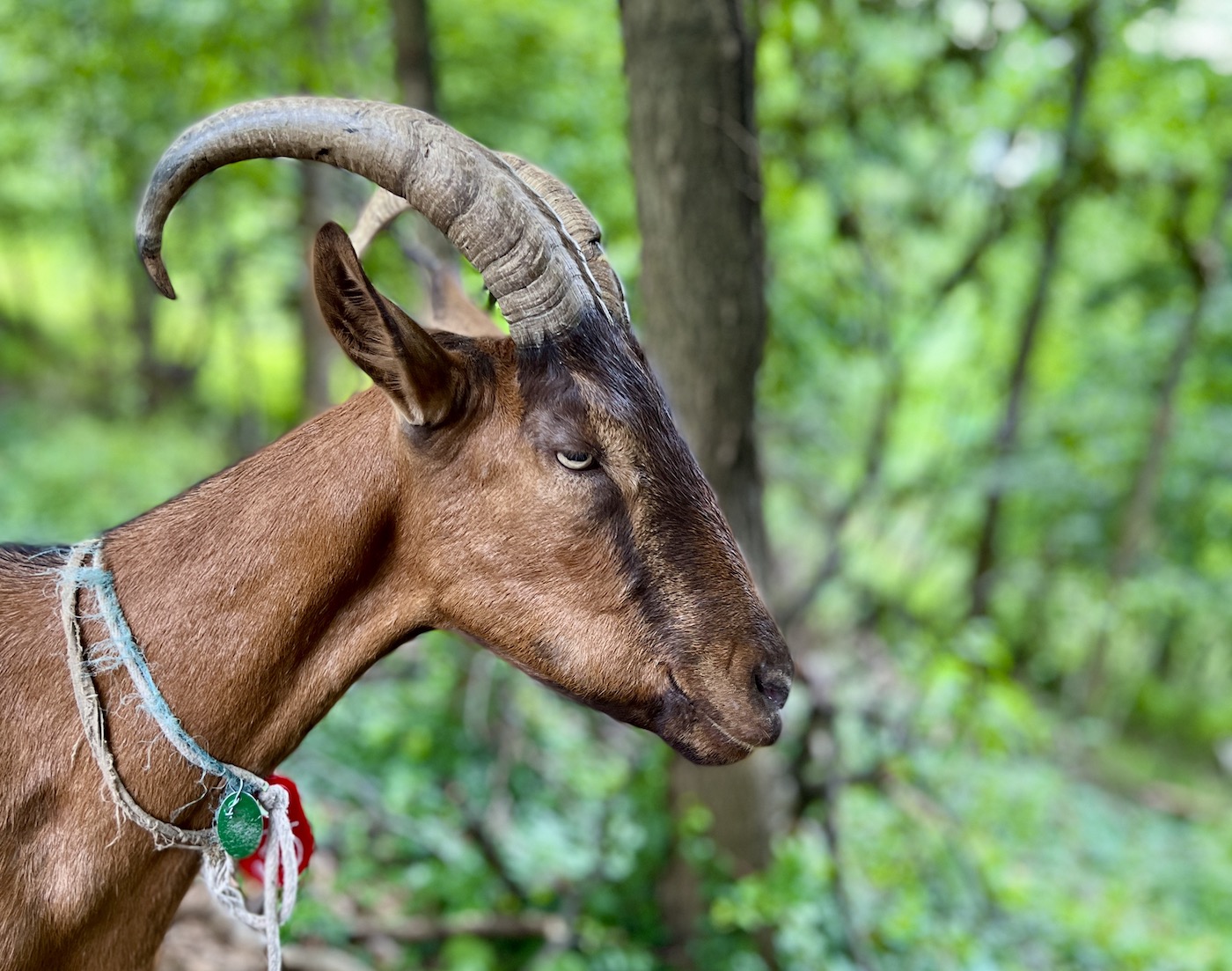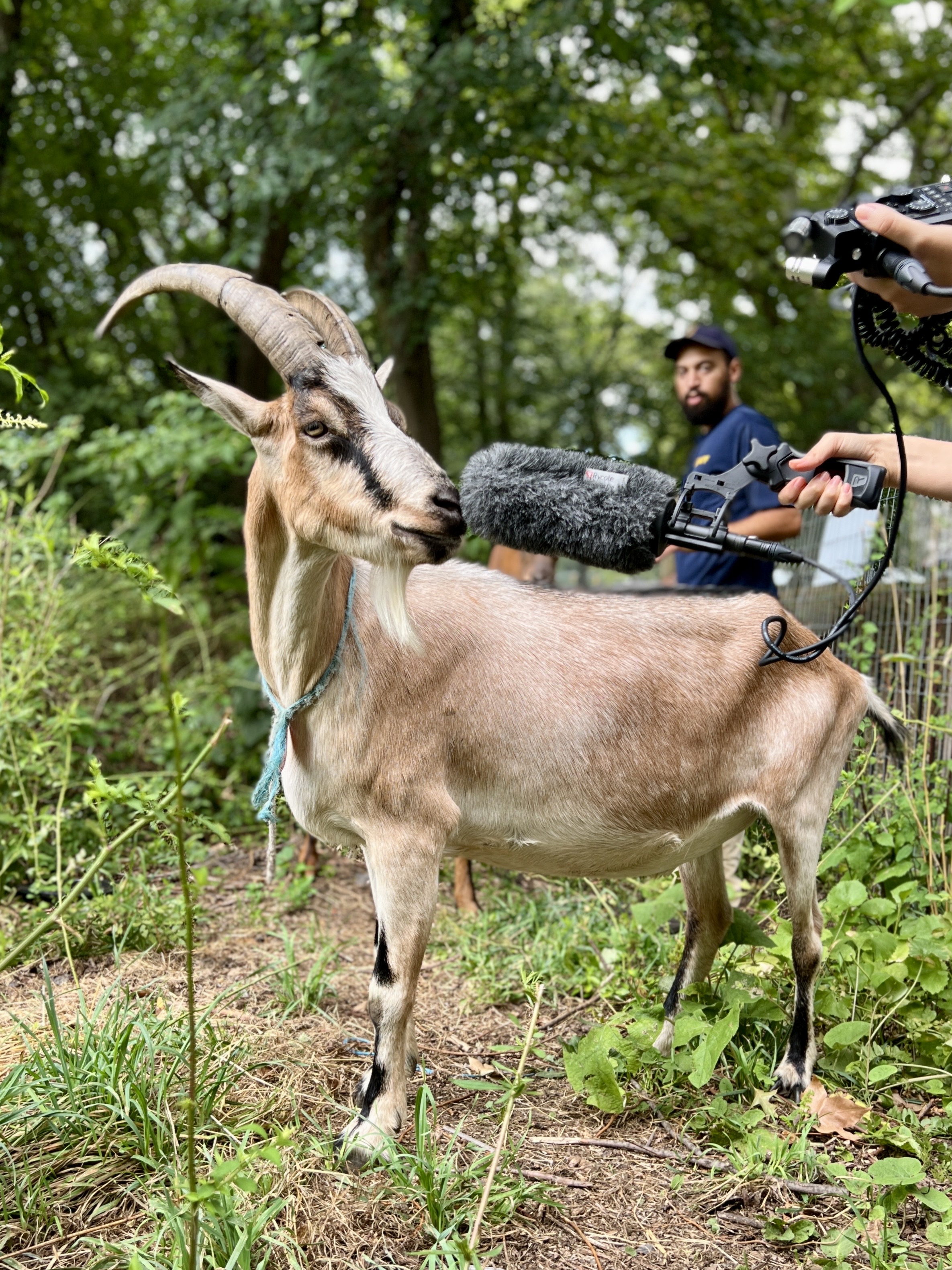The New G.O.A.T. Of Park Systems Is An Actual Goat
7:09 minutes


 If you walk into a park, the odds are pretty high that you’ll find an invasive plant species, like buckthorn, giant hogweed, or multiflora rose. These resilient plants can often grow uncontrollably and out-compete native species for resources, which has consequences for native wildlife that depend on other native plants. They can also be incredibly difficult to remove. That’s why a growing number of parks across the United States are turning to unlikely helpers: goats.
If you walk into a park, the odds are pretty high that you’ll find an invasive plant species, like buckthorn, giant hogweed, or multiflora rose. These resilient plants can often grow uncontrollably and out-compete native species for resources, which has consequences for native wildlife that depend on other native plants. They can also be incredibly difficult to remove. That’s why a growing number of parks across the United States are turning to unlikely helpers: goats.
Conservation grazing is a practice in which livestock are used to maintain biodiversity. Because goats eat almost everything, they chow down on invasive plants and make them much easier to remove.
Radio producer Rasha Aridi speaks with Hillary Steffes, the chief goat herder at Allegheny GoatScape in Pittsburgh, Pennsylvania, about using goats as a conservation tool. Then, Rasha takes a trip to Riverside Park in NYC to meet some goats, and talk with Marcus Caceres, a field supervisor at the Riverside Park Conservancy.
Invest in quality science journalism by making a donation to Science Friday.
Marcus Caceres is a field supervisor with the Riverside Park Conservancy in New York, New York.
Hillary Steffes is chief goat herder with Allegheny GoatScape in Pittsburgh, Pennsylvania.
IRA FLATOW: If you’ve ever been around goats, you know they’ll eat, well, just about anything and everything, which makes them perfectly fitted to spruce up overgrown, weedy areas, including urban spaces. SciFri radio producer Rasha Aridi is here to tell us more about her experience with goats. Hi, Rasha.
RASHA ARIDI: Hey, Ira. So I live in New York City. And a little while ago, I heard that a herd of goats had taken up residence at a park near me, and they were there to help with conservation efforts. And it sounded strange, right? Because you usually hear about livestock harming biodiversity instead of helping it.
IRA FLATOW: Yeah. Yeah. Livestock and conservation are sort of on the opposite ends of the feedlot.
RASHA ARIDI: Yes, exactly. And this concept of using livestock to help with conservation is called conservation grazing. And the goats are there to chow down on invasive species. So I was wondering, does using goats actually work? And is there any harm in it?
So I called up Hillary Steffes. And she has the best job title I’ve ever heard– she’s a chief goat herder. And she works for a nonprofit called Allegheny GoatScape, which takes goats all around Pittsburgh, Pennsylvania, to munch on invasive plants.
HILLARY STEFFES: Yeah, they’re very industrious, and they’re very hungry. They eat a few pounds of food a day, which, if you think about how many leaves it would take to make 4 pounds, that’s a lot of volume. So we’re just paying them to do what they want to do already. They’re also good at navigating challenging topography. They just run up and down these cliffs pretty impressively.
RASHA ARIDI: So Hillary, how do the goats do their job? And where do you fit in?
HILLARY STEFFES: Working with the goats is a fun collaborative effort. We usually set up a site and let them do some work. And then once they have thinned out the vegetation to a degree, that allows us to come through with our tools and mechanically remove certain plants.
RASHA ARIDI: Are there any downsides to using goats? Like, what should people be careful of?
HILLARY STEFFES: People think that goats are a one-and-done solution. And that’s a misconception. Goats are going to come through, and it might seem impressive how quickly they reduce the vegetation that you don’t want. But vegetation is strong and typically storing a lot of energy in a root system, so you’re going to need several seasons to weaken and replace an entire plant community.
RASHA ARIDI: Are there any concerns about the goats chowing down on native plants or causing erosion to these parks?
HILLARY STEFFES: Yeah, goats could actually do a lot of damage to a site if not managed properly. So when we set up a site, first we make sure that we’re avoiding large stands of natives. Or if there’s a handful of trees worth saving within the site, we might create an enclosure within there or put some fencing around the trees.
Also, if goats are left on a site for too long, they can certainly disturb the soil and be cause for erosion. So in order to avoid that, we just make sure that we’re moving them around in proper timing. And also, if a goat has been on a site that’s very steep and they’ve been wearing away at the soil and the grass, reseeding afterward would just be a simple follow-up.
RASHA ARIDI: And do you have a favorite part of working with goats?
HILLARY STEFFES: Yes, I have very nice coworkers. I’m never complaining about my coworkers. They’re very soothing. I do really like looking around while working and thinking about the fact that me and the goats together are working on this huge ecological project. And it feels like we’re making a difference.
RASHA ARIDI: Because goats have such a great track record at removing invasive species, a growing number of parks across the country are recruiting their help. They’re in cities like Madison, Wisconsin; Minneapolis, Minnesota; Boulder, Colorado. So I took a field trip to my local goat park, Riverside Park in New York City.
[CLAPPING]
MARCUS CACERES: Ladies, ladies, come on ladies. Let’s go. How you doing? Hey, baby.
RASHA ARIDI: I met with Marcus Caceres. He’s a field supervisor at the Riverside Park Conservancy. And he’s in charge of the park’s four goats– Cheech, Eleanor, Big G, and Skittles.
MARCUS CACERES: Like that, Cheech? Yeah? They love it here. They get pampered every day. They get petted every day. They’re all retired, and they just eat a whole bunch of food every day.
RASHA ARIDI: Riverside Park is sandwiched between the Hudson River and a busy part of Manhattan. So there are lots of cars and sirens and airplanes flying overhead. But it’s on a really beautiful hillside, though, with lots of old trees and trailing vines. For the third time, Riverside Park has brought goats to lend a helping hoof in clearing out invasive plants, which outcompete with native species. And that can have negative effects on the native wildlife that depend on those plants for food or for a home, for example.
MARCUS CACERES: Riverside Park was built in the ’30s. So technically, a lot of the spaces that we do have here are disturbed, which makes it easier for invasive plants to take hold and not so easy for native plants because they don’t know the area. And then invasive plants are like, I don’t care. I’ve been here for a long time. This is totally fine.
RASHA ARIDI: That’s where the goats come in. Some of their favorite foods just so happen to be the plants that the Conservancy wants gone. And their 2-acre enclosure is a giant, leafy buffet. The goats usually go after–
MARCUS CACERES: Burdock or some multiflora rose, porcelain berry, some mugwort, all the common weeds and invasive plants that we have in the park. But they won’t go after asters, white snakeroot, all those herbaceous species that are native for our area. It’s a win-win for us.
RASHA ARIDI: Take multiflora rose, for example. It’s a really pretty shrub with white flowers, but it’s a very invasive plant. It forms tangled, almost impenetrable thickets that make it difficult for native plants to grow. But the goats, they love it.
MARCUS CACERES: They munch off all the leaves, and they leave the stems. Sometimes, they’ll even munch on the stems, too, especially if it’s new growth. They really like the new growth because it’s filled with moisture and nutrients. The old growth is very woody and hard to munch on. And then that’s where I come in, to cut that so that that can be removed. And then new shoots are being created, and then the goats are always attacking that new growth. And then that’s how we stunt the growth.
RASHA ARIDI: Besides being really great at their job of clearing out invasive plants, there’s another reason the Riverside Park Conservancy keeps inviting the goats back. It’s because people love them.
MARCUS CACERES: They’re a pehnom. School groups come out. Dogs love them. They come and take pictures with them all the time. People make it part of their morning routine. And that’s what we want as a conservancy. We want people to come and use the park more. What better way of doing that than bringing a whole bunch of goats?
IRA FLATOW: Great story. It sounds like there’s no butting heads with that idea, Rasha. So where’s this team of goats now? Are they still munching away?
RASHA ARIDI: They actually just finished eating through all the plants in their enclosures, so they are out of food, and their summer job is done. So they went back home to their farm.
IRA FLATOW: Not a bad way to retire– summer in the city, you eat all day. Thanks for this story, Rasha.
RASHA ARIDI: Yeah, any time, Ira.
Rasha Aridi is a producer for Science Friday. She loves stories about weird critters, science adventures, and the intersection of science and history.